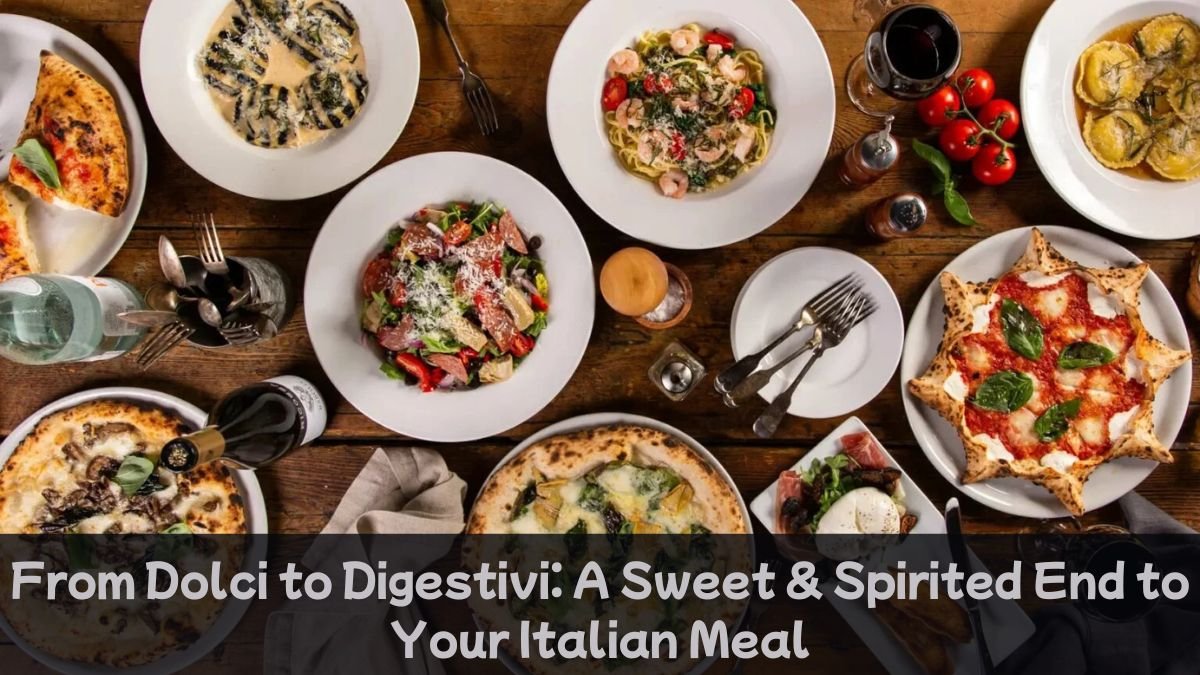Italian food is known worldwide for its taste, simplicity and tradition. We are all familiar with names like pizza, pasta, risotto, but a traditional Italian meal is not just limited to these dishes. It has a special aspect – the ending! That is, dolci (sweet) and Digestivi (after meal drink). In Italian food, the ending of the meal is given as much importance as the beginning.
In this article, let us go on a fun and flavourful journey of the final stage of an Italian meal from dolci to digestive.
What is Dolci? – An Introduction to Italian Sweetness
‘Dolci’ means ‘sweet’ or ‘dessert’. It is when something special and sweet is served after an Italian meal to satisfy your taste buds. But Italian dolci is not just about eating sweets, it is a tradition – a way to enjoy life.
Classic Dolci: Seen on every Italian table
Each region of Italy has its own special dessert, but some dolci are popular throughout the country:
- Tiramisu: This is perhaps the most famous Italian dessert. Made with coffee, ladyfingers, mascarpone cheese and cocoa powder, this sweet delicacy gives you a taste of freshness and depth in just one spoonful.
- Cannoli: Hailing from Sicily, these are tube-shaped crispy pastries filled with ricotta cheese, chocolate chips and candied fruit.
- Panna Cotta: A simple but luxurious treat made with cream, sugar and gelatin, topped with a fruit coulis or caramel sauce.
- Gelato: Italian ice cream that is less fatty and more flavourful than traditional ice cream.
Special Dolci during festivals: Sweetness according to the season
Italian festivals are also associated with certain special desserts:
- Panettone (at Christmas) – a sweet bread-like delicacy filled with dried fruits and candied peel.
- Colomba di Pasqua (at Easter) – dove-shaped bread decorated with almonds and a sugar crust.
- Zeppole (at St. Joseph’s Day) – deep-fried doughnut-like dessert filled with custard or jam.
Italian Coffee with Dolci: A Sweet Companion
Italian coffee with Dolci is very common. Especially espresso is drunk at the end of the meal after Dolci. It calms the stomach and gives your meal an intense and lively end.
Now let’s talk about digestives – what is it?
After an Italian meal, there is another important step after Dolci – the Digestivo. This is an alcoholic drink that helps digest food and makes the body feel lighter. It is often served in a small glass.
Popular Italian Digestive Drinks
There are many types of digestives available in Italy, the most popular of which are:
- Limoncello: A sweet, cool and refreshing liqueur made from lemon peels. It is popular in Southern Italy, especially Naples and the Amalfi Coast.
- Grappa: A strong and fizzy liqueur made from the seeds and skins of grapes. It is a specialty of Northern Italy.
- Amaro: It means ‘bitter’. It is made from herbs, flowers, bark and spices and has a slight sweetness and tartness.
- Sambuca: A clear liqueur with anise flavour that is often served with three coffee beans – a symbol of health, prosperity and happiness.
When and how are digestives drunk?
Digestives are always served at the very end of a meal. They are usually served chilled (like limoncello) or at room temperature (like grappa). Some people sip it slowly, while others finish it in one swig.
Ending an Italian Meal: An Experience, a Tradition
What is special about Italian food is that there is an emotional connection behind every course, every taste and every drink. Dolci and digestives are extremely important not just from a taste level, but also from a cultural perspective.
They make a meal not just a meal, but an experience — an experience that people share with friends and family.
Dolci and digestives: Growing in popularity in India
Italian food is growing rapidly in India too. Tiramisu, Panna Cotta and Limoncello are common dishes in metro restaurants. People no longer limit Italian food to just pizza and pasta, but have come to know and embrace the full tradition.
Conclusion
‘From Dolci to Digestivi’ – these are not just the two final parts of a meal, but a philosophy of the Italian way of life. While Dolci symbolizes sweetness and satisfaction, Digestive is an experience of peace of soul and relief of body.
If you ever want to enjoy the true pleasure of Italian food, then the next time you have pasta or risotto, try a good Dolci followed by a Digestive. It will connect you to the depth, culture and soul of Italian food.
